Jacob Daly kept in touch with the different strands of his heritage. He wrote in Dutch and in English, he raised his extensive family in Zeerust but kept in touch with the Daly family in Potchefstroom. As in the case of the family descended from his older brother, Ramsay, he was sympathetic to the Boer side in the Anglo-Boer War but this did not seem to damage his relationship with two young sons, Albert Edward and George Gilbert who served under the British in the Zeerust Town Guard. Demonstrating their continued allegiance to Zeerust, Jacob, both his wives, many of his children and his nephew William are buried in the Zeerust cemetery.
Zeerust was a small, rural town so, not surprisingly, the family spread out. Ramsay remained in Zeerust but others left to earn their livings elsewhere. Albert Edward headed for Johannesburg where he is recorded as being a “Native Recruiting Agent”, presumably for the gold mining industry. Others headed for the fresh opportunities offered by Rhodesia. The family ties remained strong. After many years in Rhodesia, for example, Jennie returned to Zeerust to join brother Ramsay but stopped along the way to visit brother George Gilbert and his family living in Kroonstad. George had his son drive her back to Zeerust in her Ford Prefect.[1]
George Gilbert deserves our further attention. He joined the Zeerust town guard at the age of 16 years for which he was awarded the Queen’s South Africa Medal. He joined the Civil Service and served in the Department of Justice having passed the exam to qualify him as a lawyer.[2] Here he is elegantly dressed in 1910 at the age of 26. Next to him is an early portrait of Alyce Louise Shorten whom he married in 1914. Like George’s mother, Alyce was from 1820 settler stock.
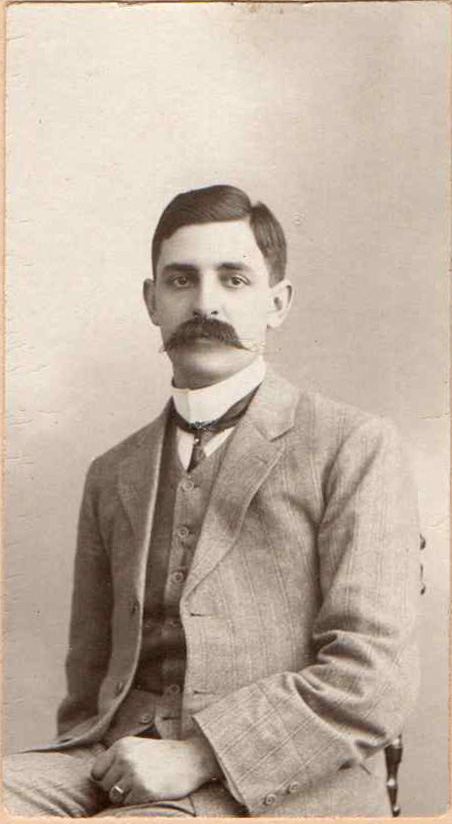
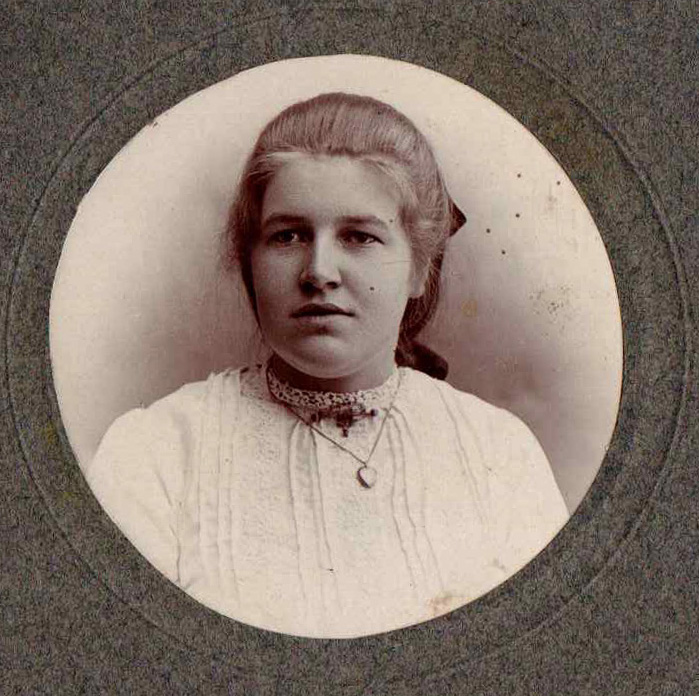
Shortly after their marriage, George left, joining the World War1troops invading German-held South West Africa (now Namibia). That campaign ended within a year and George came home to Alyce (with three more medals). He became a magistrate, serving in various rural towns including Nylstroom where his cousin Jean Daly had practised earlier. The family later settled in Kroonstad
Here is George Gilbert’s family in 1926 or 7:
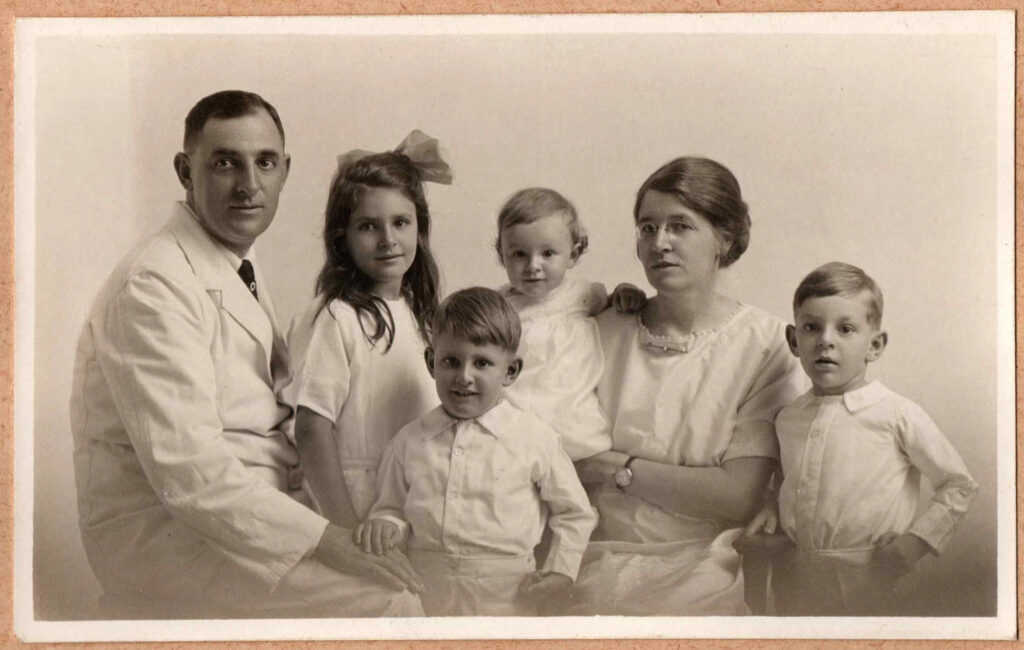
The little boy in the front of his parents is Patrick Michael Daly and there will be more about him later.
Here they are again in1930 with Patrick Michael again in the front row.

George took a keen interest in the family and, in his letters, he recounted their achievements. Writing to his daughters, whom he nicknamed Fatty and Pampoen, he signed off as “your doting papa”. He told of the family history including the story of his parents Jacob and Sarah Jane building their own house:
Dad told me mother helped him to mix the clay for mortar and carried on bricks. Would any of these lipsticked painted nailed females today help their husbands like that … Dad went with three wagons and oxen from Zeerust to Grahamstown to fetch yellow wood baulks and planks for the roof. It took 6 months. I am that man and woman’s son and damned proud of it.
George inherited from this couple a powerful sense of family and he set in place the expectation that they would maintain close family contact. If they were away he expected to receive a letter every week and he responded in chatty and informative letters.
George and Alyce’s son, Patrick, was called up in 1940 at the start of the Second World War. He was not yet 20 years old and the family gave him a fond farewell. Here he is with Alyce and George, ready to depart. At the time of his call up Patrick was working for the South African Press Association and this may have made it easier for him to comply with George’s request to write home every weekend.
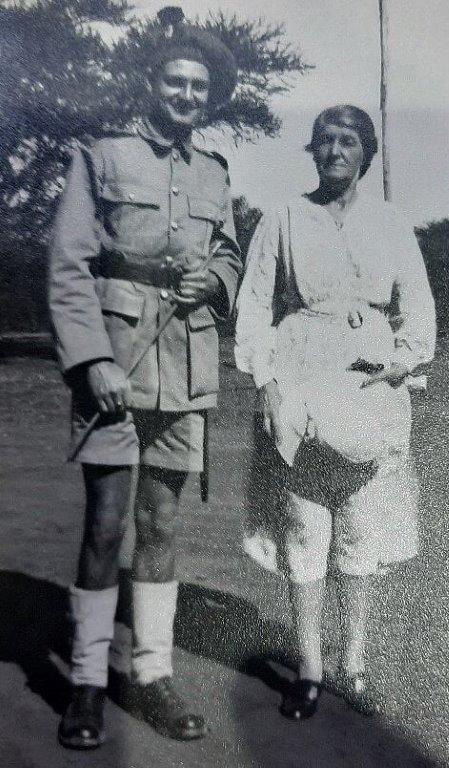
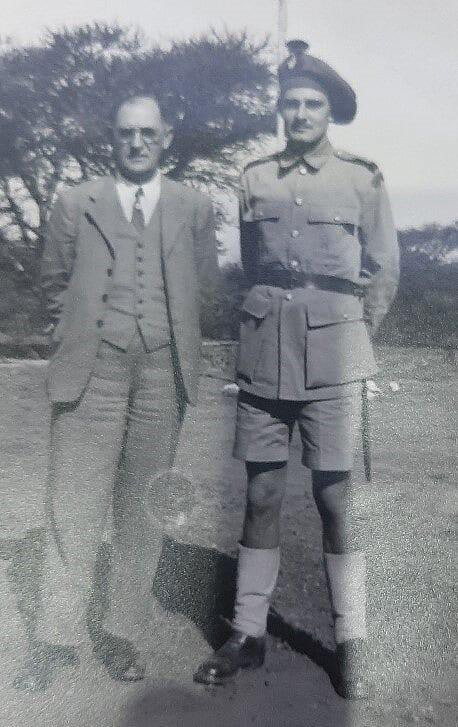
Patrick was shipped to Europe as a member of the First South African Irish regiment and had a “jolly fine time” on board as they sailed up the East coast of Africa to disembark in Nairobi. He sent weekly letters to “My dear Mom and Dad” and other family members. He told in vivid detail about the trials of serving in the “hell hole” of tropical Kenya and then on North, fighting against Italian troops. As he went there was a constant stream of family correspondence, parcels and newspapers . George was able to provide him with replacement for the spectacles he had broken. In return Patrick sent souvenirs home. He hoped to be home by Christmas. Instead he was shipped to Cairo where he met his uncle, Raymond, serving with the Navy. What is clear from the letters that Patrick wrote and reference to letters and parcels received is that they sustained his optimism that he would see them all soon. Alyce was an active participant in the letterwriting but so were other members of the family, siblings as well as aunts and uncles.
After arriving in North African Patrick’s regiment faced the German army. In 1941 the Allied forces at Sidi Rezegh suffered a heavy defeat. Patrick’s regiment was destroyed and he was taken prisoner. George and Alyce were advised that he was missing in action. Only later did they discover that he was a prisoner of war in Italy, then Germany, then Poland. Throughout the next four years of deprivation and suffering, Patrick’s letters from home kept up his spirits; he wrote dutifully in return. When the mail was interrupted and parcels delayed he suffered. The family never waivered in their commitment to Patrick but lost track of him when he was part of the Death March[3] in the winter of 1945, across Germany to final liberation in England and then, finally, home to South Africa and his family.
What this history tells us is how powerful the family bonds were in George and Alyce’s family. The letters Patrick wrote home were preserved, every one of them, and passed on to Patrick by Alyce and then on to George and Alyce’s grandson, Terence Michael (Mike). This trove of Letters Home has now been published as a book, aptly titled Letters Home. Although we have only Patrick’s letters, the care and communication from George, Alyce and other family members is clearly displayed.
[1] Much of the information drawn on in this section was provided from the family records held by Mike Daly. This includes the photographs. The later section on Patrick is published in his book, Letters Home see https://www.amazon.com/Letters-Home-Terence-Michael-Daly/dp/0620820179/ref=sr_1_2?dchild=1&keywords=letters+home+daly&qid=1591756477&s=books&sr=1-2
[2] See Jacob Daly’s history.
[3] See, for example, the account in https://www.bbc.co.uk/history/ww2peopleswar/stories/53/a2759853.shtml
